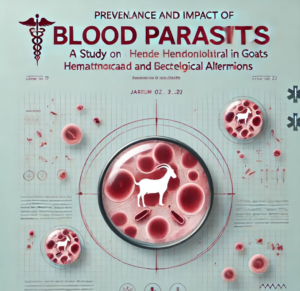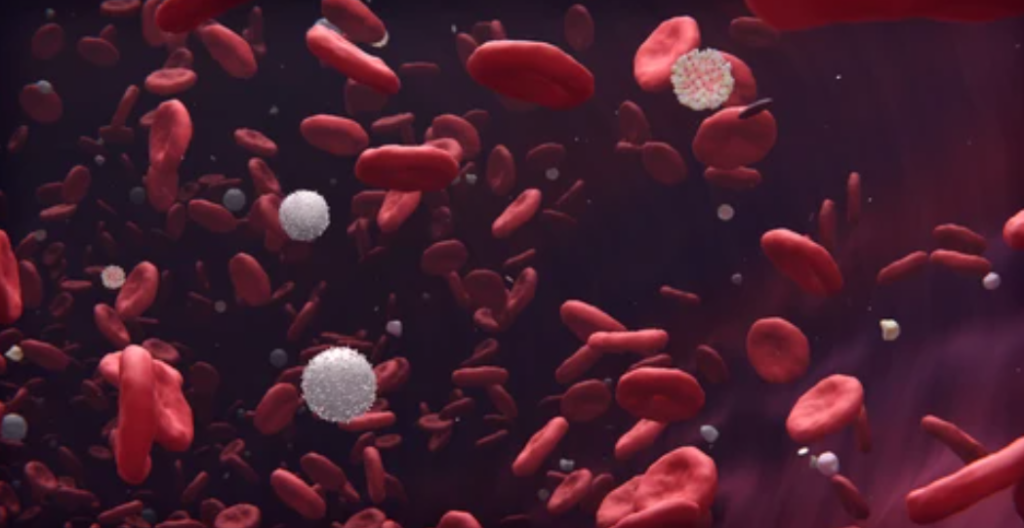Here is a detailed study to know about the Prevalence and Impact of Blood Parasites in Goats. Several reports do not acknowledge some goat breeds in Pakistan. As there is variation in dialect after about 100 km, the coat color of the goat also varies. This variation can be after some distance, and the vernacular names of the breeds may also differ. Some of the breeds have their names after particular areas while few are named after their specific traits e.g.
Nachi goat carried this name due to its dancing gait. The origin of the goat breeds is not accurate; they do overlap as they do not follow any specific pattern. Pak-Angora (Angora x Hairy) is the only hybrid breed developed in the 60’s. It couldn’t become popular at the farmer level and is confined to research institutes. The domestic breeds in Pakistan are Dera Din Panah, Beetal, kamori, Teddy, and Nachi (Khan et al. 2008).

Study on Blood Parasites in Goats
A study was performed on 97 goats of both sexes, 82 out of them were already infected with blood parasites. They were categorized into three groups based on biochemical and hematological tests, 24 were infected with Anaplasma ovis. Here, 30 were infected with Babesia motasi and 28 infected with Theileria hirci (Th.lestoquardi), While 15 clinically healthy goats were considered control group.
Results showed that parasitic infections altered the blood parameters i.e. the Total Erythrocyte Count, Hb concentration, and PCV. They were significantly declined, on the other hand, there was a significant rise in the ESR. In addition, Anemia of different types was also found based on the type of infection(El-Metenawy 1999).
Economic Impact of Blood Parasites on Small Ruminants
The major vectors of piroplasms i.e. babesia and theileria are ticks and in small ruminants borne diseases. It is usually caused by ticks are contributing toward the great economic losses to the livestock industry in Asia, particularly in Pakistan. The blood parasites cause anemia that leads to morbidity and mortality in animals resulting in decreased milk and meat production as compared to healthy animals (Khattak et al. 2012).
Blood parasites have long been regarded as a major problem in sheep and goat production. Theileria hirci, Babesia motasi, and B. ovis are the most pathogenic protozoa. Anaplasma ovis Babesia Crassa and Eperythrozoon ovis are usually non-pathogenic and they do not cause any significant problem. The major tick genera that affect sheep and goats are Rhipicephalus, Hyalomma, Ixodes, Haemaphysalis, and rarely Dermacentor(Hashemi-Fesharki 1997).
Major Vectors and Disease Transmission
Theileriosis, caused by Theileria ovis and Theilria Lestoquardi (hirci) is an economically significant disease of small ruminants in tropical and subtropical regions(Al-Amery and Hasso 2002; Guo et al. 2002; Sugimoto and Fujisaki 2002).In sheep and goats, Theileria leptoquarks is a cause of malignant theileriosis which is an acute lymphoproliferative disease with high mortality and morbidity(Sasmal et al. 1982) (Yin et al. 2003).

Ticks act as vectors for Theileria leptoquarks causing anemia, fever, lymphadenopathy, wasting, and jaundice. Disease usually exists in acute form but chronic and subacute form also exists. The disease is prevalent mostly in the Middle East North Africa and India (Al-Amery and Hasso 2002).
Rhiphicephalus and Haemaphysalis are important species of tick vectors for the Iberia.
Clinical Symptoms and Diagnosis
During the tick infestation theileriaenters the host as sporozoites, and quickly invade mononuclear leukocytes. The sporozoites are metamorphosed into macroschizonts that transform further into microschizonts and finally into merozoites, which are released from the leukocyte. The merozoites enter erythrocytes and transform into piroplasms (Radostits et al., 2000). Cows and buffaloes with subclinical theileriosis in endemic regions become carriers of piroplasms and act as a source of infection for the vectors.
Dullness, weakness, fever, anorexia, pale mucous membrane, swollen lymph nodes conjunctival petechial, and anemia are the most common symptoms. However at the later stages of theileriosis dysentery, diarrhea,a, and lateral recumbent are observed (Radostits et al., 2000; Stockham et al., 2000). Inthe case of theileriosis tentative diagnosis, in the field, is mostly based on clinical findings and tick infestation on the infestation animals.
Laboratory Analysis of Theileriosis
The ear of the suspected animal was cleared with 70% alcohol and punctured with a syringe to take a blood sample on a clean glass slide. Another clean slide that was held at 45°angle, was used to make a thin blood smear. After that, the smear was air-dried, and the slide was labeled from the opposite side. In the next step, the thin blood smear was fixed with 99% methanol for 5 minutes, stained with 5% diluted giemsaa stain, and left for 30 minutes. In the next step the smear was rinsed with tap water and left to dry. Finally, these blood smears were examined under a light microscope with an oil immersion lens for the presence of Theileria piroplasms(Hoghooghi-Rad et al. 2011).
Blood Smear and Microscopic Examination
The complete blood count also known as CBC with differential is considered as most common lab test nowadays. It provides us with information about all blood cell production and helps us to identify the patient’s bloodoxygen-carryingg capacity with the help of RBC indices, hemoglobin, and hematocrit. Through the evaluation of WBC count, we are also able to get information about cells involved in immunity. CBC is helpful in diagnosing certain cancer, anemia, infection, allergies as well as immunodeficiencies.

Dipstick tests for urinalysis are widely used as a screening tool for the general examination of urine in both human and animals. It is easy to perform in all condition, cost effective, can be repeated conveniently and provides quick results. Moreover, small volume of urine can be used on the test strips for reliable results. That’s the very reason dipsticks tests are widely used in the veterinary clinical practices(Balogh et al. 2017; Center et al. 1990; Lage 1980).
Additional Diagnostic Tests
Renal function tests (creatinine and Blood Urea Nitrogen) will be performed using serum chemistry analyzer to help diagnose the kidney function of theileria positive goats. If the level of creatinine and nitrogen in the blood is higher, these tests indicate that kidneys are not functioning properly to clear these waste products from the blood
Like all over the world theileriosis is a significant affliction in sheep and goats in Pakistan. 529 animals (sheep and goats) were chosen to determine the spread of this disease in Lahore, Pakistan. After making blood smear and examination under a microscope, 59/529 (11.2%) samples were positive for theileria. The prevalence of Theileria spp. was observed to be 8.2% and 13.9% in goats (21/256) and sheep (38/273)(Naz et al. 2012).
Prevalence of Theileriosis in Pakistan and Other Regions
N.ullah et al (2018) designed a study to find the pervasiveness, risk factors, and relation of certain host biomarkers with theileriosis. To pursue this study a total of 600 blood samples were obtained, 200 each from goats of three districts of southern KPK, Pakistan.
Epidemiological Studies in Pakistan
On performing a Hematobiochemical examination it was observed that there was a significant (P < 0.05) decline in red blood cells, Hb, PCV, white blood cell level, and glucose whereas there was a significant increase in ALT, AST, urea, and serum creatinine in the infected goats. The substantial changes caused by Theileria lestoquardi on the blood and serum profile of the diseased animals were highly considerable as compared to Theileria ovis illustrating consequential damage to the liver and kidney(Ullah et al. 2018a; Ullah et al. 2018b).
Comparative Studies in Iraq for Blood Parasites in Goats
Marai & Mohammed et al (2019) conducted a study to determine the hematological and biochemical alterations, in sheep and goats suffering from theileriosis, the study was conducted on 145 sheep and 108 goats aged 1-4 years, from April till August 2017 at Al-Najaf province-Iraq.
In both control and infected animals, respiration rate, heart rate, body temperature, and hematological and biochemical parameters were examined which included RBC count, TLC, Hb level, PCV, Mean Corpuscular Volume, MCH, MCHC, DLC, total bilirubin, total plasma protein, ALT and AST enzymes.

The results illustrated serious increase in heart rate and respiration rate in sheep and goats infected with theileriosis, while the body temperature didn’t show extreme differences, also in hematological parameters there was considerable decrease in PCV, Hb level, red blood cell, MCV, MCH, MCHC, total leukocytes count, lymphocytes, while the monocytes and basophils did not show significant alterations and there was a critical increase in neutrophils and eosinophils in diseased sheep and goats when compared with the control animals, biochemical tests revealed a notable increase in ALT, AST, and total bilirubin while significant decrease in total plasma protein(Mahmoud et al.).
Impact on respiration, heart rate, and organ function
In 2011 I.K. zangana et al performed a study to determine the prevalence of Theileria hirci and Babesia motasi in goats in the Duhok area of Iraq. However, 500 local black breed goats represented various flocks from different areas went through clinical and laboratory examinations to observe the presence of hemoparasites in blood smears.
The diagnostic findings showed that 20.8% of the goats were infected with T. hirci and 4%were infected with Babesia motasi. Hematological observations, showed a considerable decline in RBCs, Hb concentration, and PCV besides the significant rise in the MCV. No significant alterations in MCH, and MCHC values were noted(Zangana 2011).
Significance of blood parasites in goat health
Riaz and Tasawar et al (2017) conducted a study to determine biochemical and hematological alterations in sheep and goats naturally infected with Theileria spp. Infection. CBC parameters illustrated a prominent (p < 0.05) decline in total erythrocyte count, Hb concentration, PCV, MCH, and MCHC values. While non-significant (p > 0.05) correlation in MCV values of Theileria infected sheep and goats.
Biochemical testing showed a notable (p < 0.05) decline in total serum protein and albumin concentration while a non-significant (p > 0.05) increase in urea and cholesterol levels in diseased animals compared to normal animals(Riaz et al. 2019; Riaz and Tasawar 2017).
Biochemical Changes in Small Ruminants with Theileriosis
N.Gunes et al (2015) carried out a study to evaluate changes in some biochemical parameters in healthy small ruminants and those infected with Theileriosis. 65 sheep and 67 goats were selected in the study. PCR and RLB techniques were used for the identification of hemoparasites in the blood samples.
They observed a decline in the levels of albumin, total proteins glucose, and increases in alanine transaminase and aspartate aminotransferase enzyme values in the diseased animals compared with the control group.
However, this study showed that anomalies in some biochemical parameters may happen and in terms of PCR can be found in diseased animals that are in the initial phase of infection and do not exhibit any clinical signs(Gunes et al. 2016).

Hematological Profile and Incidence of Haemo-Parasitic Diseases
In 2017 Shah et al designed a study of finding the hematological profile and incidence of haemo-parasitic diseases in sheep and goats and associating it with its health profile. 249 blood samples were collected from sheep while 52 blood samples were collected from goats, from different districts of Peshawar and Khyber agency. Different tests were performed to find the heamo-parasites and various hematological parameters were also analyzed.
Prevalence of anaplasmosis was 40%, babesiosis was 7% and theileria was 6%. Hematological analysis diseased animals exhibited a significant decrease (p<0.05) in Total Erythrocyte Count, Hb level, PCV, MCH, and MCV while no significant deviations(p>0.05) were observed in MCHC and Total Leukocyte Count. Onthe basis of erythrocytic indices in sheep anemia was recorded as macrocytic normochromic while in goats, anemia was classified as macrocytic hypochromic(Shah et al. 2017).
Clinical Findings and Hematological Changes in Goats with Theileriosis (Iraq)
In Iraq a survey for theileriosis in goats was conducted. The study confirmed Theileriosis infection based on clinical findings as well as hematological alterations that were observed in 150 goats. However, then 50 goats were found as a healthy group in which no abnormality was observed. However, these may include (Respiration, pulse, and temperature were in normal ranges). But 100 goats recorded infected had a rise in respiration pulse and temperature, paleness of mucous membrane, enlargement of lymph nodes, and weakness. In CBC parameters significant (p<0.01) decline in erythrocyte count, Hb concentration, PCV, and WBC count was observed(p<0.05)(Salman and Kareem 2012).
Prevalence and Hemat – Blood Parasites in Goats
150 goats were selected at a slaughterhouse in Nigeria and blood samples were collected from them. Mixed infections due to Anaplasma, Theileria, and Babesia were detected. When the blood samples were used for diagnostic purposes. Here they made blood smears Anaplasma Ovis was found to be most prevalent.
The Packed Cell Volume, Hemoglobin levels, Total Proteins, and Leukocyte counts in the diseased goats (infected with any of the hemoparasites) were not found to be considerably different(P>0.05) from the goats that were found negative. However, notable differences (P<0.05) were observed between the goats suffering from non-hemoparasitic infections. Those infected with T.ovis(Mohammed and Idoko 2012).
Complete Blood Count (CBC) Parameters in Healthy Goats (Iraq)
200 normal and healthy goats (90 males and 110 Females) were selected. It depended on clinical examination in the Al-Najaf slaughterhouse (Al-Najaf, Iraq) and were categorized into different age groups. For this study, blood samples were obtained from the jugular veins of the animals. So, they can determine of Hb concentration, PCV, TEC, and TLC, and sub-determination of white blood cells including monocytes, basophils, lymphocytes, and band cells.
Results illustrated that there were non-significant differences between male and female CBC parameters in all age periods. However, there is an exception that small lymphocytes in a goat larger than 1 year old and Neutrophils for less than 6 months of age(Shamsa 2020).
Protein Alterations in Theileria-Infected Goats
20 goats suffering from theileriosis were selected and blood samples were collected from them. All of them showed swollen lymph nodes and paleness of mucous membranes. 20 noninfected goats were selected as a control group and blood samples were also taken from them.
Serum samples were used for the detection of total protein by colorimetric assay and protein fractions were separated by electrophoresis. The results were compared using an unpaired two-tailed T-test. Their statistical results showed significant differences for total protein, albumin, α-globulins, γ-2 globulins. They were infection with theileriosis in goats intense hypoproteinemia, hypoalbuminemia increased α and γ-2 globulins, and decreased albumin/globulin (A/G) ratio(Kareem 2016).
Prevalence of Blood Parasites in Goats (Pakistan)
For Blood Parasites in Goats, 8 disease-free goats were selected and blood samples were taken from them 28 goats. They were affected with Theileria lestoquardi were chosen and blood samples were collected. The infected goats were found positive Like all over the world theileriosis is a significant affliction in sheep and goats in Pakistan. 529 animals (sheep and goats) were chosen to determine the spread of this disease in Lahore, Pakistan.
After making a blood smear and examination under a microscope, 59/529 (11.2%) samples were positive for theileria. The prevalence of Theileria spp. was observed to be 8.2% and 13.9% in goats (21/256) and sheep (38/273) (Naz et al. 2012).
Pathogenicity of Theileria in Wild Artiodactyls
Clift et al, conducted a study on wild artiodactyls in which they studied the pathogenicity of theileria. It was found that regenerative anemia was common. Along with anemia, common gross lesions included hemorrhages, icterus, lung edema, fluid accumulation in various body cavities. It also includes some foci of creamy appearance of different sizes were found that showed leukocyte infiltration in many organs.
Histopathological findings included a breakdown of atypical WBCs. So, it is in corresponding intracellular schizonts, vasocentric hyperproliferation, edema, hemorrhage, and parenchymal necrosis (Clift et al. 2020).
Haemato-Biochemical Changes in Theileria-Infected Goats (India)
Manohar et al undertook a study to determine the haemato-biochemical changes. They’re related to clinical cases of theileriosis in the positive blood smears of twenty-five goats, in the Thrissur district of Kerala, India. Critical clinical findings were fever, anemia, anorexia, lymphnode enlargement, and respiratory distress. However, hematological and biochemical analysis showed macrocytic hypochromic anemia with low PCV, Hb concentration. It has less thrombocytopenia, decreased Total erythrocyte count(TEC), and hyperglobulinemia along with hypoproteinemia in the affected goats(Manohar et al. 2021).
Conclusion – Blood Parasites in Goats
In conclusion, Blood Parasites in Goats, Begam et al, conducted a study in which blood samples. He collected from 11 goats, which showed hyperthermia, weakness, dullness, and pale mucous membranes. Blood smears stained with Giemsa stain were prepared and observed under a microscope. However, the blood smears revealed the occurrence of Theileria spp. 72.73% (8/11) based on morphological features. Here a ring, dot, tail, pyriform, rod, crescent and comma-shaped form were observed inside the RBCs(Begam et al. 2018).


